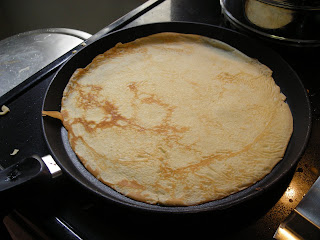
Thursday, February 28, 2008
Daring Baker's Challenge: Julia Child's French Baguette

Monday, February 25, 2008
Cinnamon Buns for a Cold Winter's Day

I don't know about you, but in the winter I crave cinnamon. Anything warm and sweet with cinnamon in it just calls my name. So this past weekend, with the snow falling, I decided to break out The Bread Baker's Apprentice and try Peter Reinhart's cinnamon buns.
I'm quite the novice at the old yeast thing. Just having something "alive" in my baked goods gives me the willies. But in reality, yeast is so easy to work with and makes you feel like a bread-baking phenom. I mean, all you really need is a KitchenAid mixer and a packet of yeast. You can do anything!
So I got out my mixer and my yeast (and other necessary ingredients) and went to town. The buns were very easy to make, easier and less time consuming than the Brioche Sticky Buns I have made in the past. But I have to say, the Brioche buns are lighter and have a wonderful taste and texture, and I like them a little more....probably due to the 5,000 pounds of butter you put in them!! Actually, the brioche buns call for 1.5 sticks of butter (16 Tb.) plus one stick for the topping, where these cinnamon buns call for 51/2 Tb. of butter. Many fewer calories! And the brioche buns call for 5 eggs, while these call for only one. So if you are feeling rather decadent and like you can spare a few hundred calories, make the brioche buns. But if you just want the yummeee taste and smell of a warm cinnamon bun without a billion calories, these are for you. All time requirements are in RED.
Ingredients:
6 1/2 Tb. granulated sugar
1 tsp. salt
5 1/2 Tb. unsalted butter at room temperature (but not too soft or runny)
1 large egg, slightly beaten
1 tsp. lemon extract or 1 tsp. grated lemon zest
3 1/2 cups all purpose flour
2 tsp. instant yeast
1 1/4 cups whole milk at room temperature
1/2 cup cinnamon sugar (6 1/2 Tb. granulated sugar plus 1 1/2 Tb. ground cinnamon) *** I would double this for a greater cinnamon taste.
Glaze:
Sift 4 cups of powdered sugar in a bowl. Add lemon, orange or vanilla extract, and 6 Tb. - 1/2 cup of warm milk. Whisk quickly until all the sugar is dissolve, adding the milk slowly until it is a thick and smooth paste.
For buns:
Cream together the sugar, salt and butter using the paddle of an electric mixer.
Whip in the egg and lemon until smooth.
Add flour, yeast and milk.
Mix on low speed until you get a ball, switch to the dough hook, increase to medium speed and mix for about 10 minutes. (if kneading by hand, it's about 15 minutes). Your dough will be silky and tacky but not sticky. Add water or flour as needed to achieve this consistency.
Lightly oil a large bowl and tranfer the dough to the bowl, coating the dough ball with the oil. Cover bowl with plastic wrap and let rise for 2 hours at room temperature. Dough should double in size.
Transfer the dough to a counter dusted with flour.
Roll out the dough, about 2/3 inch thick and 14 inches wide x 12 inches long if you are making large buns, 18 inches wide x 9 inches long if you want smaller buns.
Sprinkle the cinnamon sugar (I would double what he calls for, I found there to be not enough cinnamon flavor with his measurements) over the dough.
Roll up the dough into a log, starting at the side closest to you.
With the seam down, cut dough into 8 - 12 large pieces or 12 - 16 smaller pieces. Place the pieces on a baking sheet covered with parchment paper, about 1 inch apart.
****This is where I realized I didn't need 16 cinnamon buns for the following morning, and I didn't want to bake any of them at the moment. So I froze 8 to have later, and I retarded the rest of them by putting the other 8 in the refrigerator. The next morning, I took them out of the refrigerator and let them rise for 3.5 hours on the countertop. For the frozen ones, I will remove them from the freezer the night before and let them rise overnight on the countertop.
If you are making the buns for the same day, this is the time you will let them rise. Proof at room temperature for about 1.5 hours.
Preheat the oven to 350 degrees, and bake for 20 - 30 minutes or until they are golden brown.
Let them cool for 10 minutes, then spread the glaze over the top.
Wednesday, February 13, 2008
Happy Valentine's Day!

Tuesday, February 12, 2008
French Crepes
Last week being Mardi Gras and all, I decided to break out the crepe pan and make some crepes for dessert, just like we used to when I was living in France. The idea of crepes on Mardi Gras is to get rid of the butter and eggs from your house, since you aren't supposed to indulge in those during Lent!
So I have already done the Julia Child recipe which I really like a lot, and I decided to try Tartelette's recipe, since it calls for beer and that is something I've never put in a crepe! The idea behind the beer is that it gives the crepes these yummy holes.
I liked her recipe, although I have to say my crepes were a bit tougher than the Julia Child recipe. Could be me, could be the recipe, not sure. I filled them with homemade chocolate sauce or cinnamon, sugar and butter. They were gobbled up in no time, and my kids declared they "love" crepes! Mission accomplished.
Here is Tartelette's recipe:
Makes 12 crepes
250 g flour
2 cups milk
3 eggs
1 Tb. oil
pinch of salt
1/2 cup light beer
In a blender or food processor, combine all the igredients and pulse until fully incorporated and no lumps remain.
If you decide to do it by hand: combine the flour and salt in a bowl. Make a well in the center and add the eggs, oil and a little bit of milk. Work the batter with a whisk, and slowly add the remaining milk, until the batter comes together and the lumps disappear. Add the beer.
No matter what method you used, strain the batter if necessary. Refrigerate, covered for an hour.
In a saute pan set over medium high heat, laddle 1/4 -1/3 cup batter (depending on the size of your pan) and cook 1-2 minutes on each side.
Sunday, February 3, 2008
Pierre Hermés "Concorde"


If you like this cake, vote for me for Culinates Death by Chocolate contest!!!


















